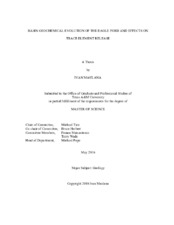Basin Geochemical Evolution of the Eagle Ford and Effects on Trace Element Release
Abstract
The Ocean Anoxic Event 2 (OAE-2) at the Cenomanian-Turonian boundary is recognized from a carbon isotope excursion (CIE) in the Eagle Ford (EF) Group, and commonly attributed to global anoxic conditions in deeper marine settings. Whereas OAE are typically marked by widespread deposition of organic-rich shales, previous work shows diachroneity between the CIE and the organic-rich Lower EF, as well as anoxia-euxinia in the Western Interior Seaway of North America. We found evidence for periodic photic zone euxinia from an EF core, based on ratios of biomarkers and redox-sensitive trace elements. Sedimentary structures suggest depositional environments above storm wave base. Integration with a sequence-stratigraphic framework emphasizes the role of estuarine-style salinity stratification, subject to redox shifts caused by storm mixing in relatively shallow water depths. Independent zircon ages indicate that transition from the Lower to Upper EF occurs in the south before the north, consistent with a northward migration of this stratification mechanism as sea level rose. This implies that the redox states during deposition of the EF leading up to the CIE were influenced by regionally distinct mechanisms at relatively shallow water depths, instead of global anoxic conditions in deeper marine settings.
Euxinic shales are rich in trace elements, so there are high treatment costs to remove trace elements that have been released to matrix acidizing fluids during production, before these fluids can be disposed or reused. By understanding mechanisms controlling the interaction between euxinic shales and acidizing fluids, it may be possible to improve the efficiency of unconventional production while simultaneously reducing environmental exposure. Trace element residency in and release from the EF were determined at different depths and under different temperatures and acid conditions. We found evidence that trace element release is mainly controlled by bulk trace element concentrations. This suggests that for the average rock, increased trace element release was associated with higher temperatures and acid concentrations, and these same conditions also resulted in higher sensitivity to trace element concentrations.
Citation
Maulana, Ivan (2016). Basin Geochemical Evolution of the Eagle Ford and Effects on Trace Element Release. Master's thesis, Texas A & M University. Available electronically from https : / /hdl .handle .net /1969 .1 /156808.


